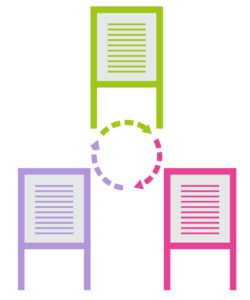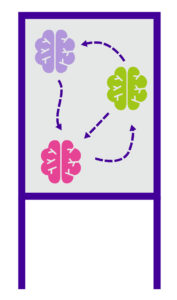My Favourite Facilitation Tools – The Essential 6

Just like a craftsman has his or her favourite clamps and cutters, I, as a facilitator, have my favourite tools for leading groups. Sure, the purpose of the meeting or the topic of a workshop comes first, and then the situation and type of the group. As the saying goes, ‘If your only tool is a hammer, everything looks like a nail’. That’s why you need a complete set of tools, so that when you need to, you can knock down the walls between people.
The international Association of Facilitators has a database with over 400 facilitation tools and methods. Some tools are tiny; just a question to get conversation flowing, or people thinking. Others are large; four day frameworks for a seminar, for example. My favourite methods are those that can be applied to short 1-3 hour meetings, or a one-day workshop. The best methods can be used in multiple situations, not just rarely. My everyday toolbox has 20 tools, and you may not need nearly that many. If you only run interactive presentations and facilitate deployment sessions for groups of 2-12 people, I believe you can survive with five tools. To facilitate the most common team and organisational development situations and customer workshops, you need at least 15 tools. Most of these tools can also be used in virtual meetings, too.
What are the top 6 essential facilitation tools and methods?
1. Cycle of Perception – when the topic or situation needs to be understood
Have you ever met a person who is really good at asking the right questions? Questions that help others gain insight? A core competence of a facilitator is to ask good questions. In the clarification stage, you need to ensure understanding of presented material, or the situation at hand. The Cycle of Perception is a framework for asking four powerful questions. It can be called a facilitated discussion. It leads into understanding and action. This method can be applied to groups of all sizes. When combined with Me-we-us, World Café, or Closed Space, it usually takes around 30-60 minutes. You can also use it in 1-to-1 conversations or even alone for personal reflection.
2. Group memory – recording conversations on a flipchart, post-its or whiteboard
The purpose of a facilitator is to help people connect with each other. Two important success factors in creating these encounters is the feeling of being listened to and keeping focus. Writing down what people say is important, writing it down on a wall so that everyone can see it, is powerful. Sure, that is not all that it takes for people to feel that they have been heard and understood, but it is a start. Notice that NOT writing something or writing it in your own words, can create anger. Be a neutral and equal recorder. This is called a group memory, because it helps us empty our minds and make space for new thoughts. Our memory gets filled fast – empty it by writing down thoughts on a paper. The group memory serves as a container for all our thoughts and ideas. It is an easy document to return to. There are different ways of using group memory: the facilitator writing down group conversation or participants writing their key points on post-its or on a flipchart. Use large markers so that all text is visible to everyone.
3. Me-we-us – when you have one topic
The simplest tool every group leader should have in their pocket is Me-we-us. This is the fundamental method to make group-work interactive. With Me-we-us you can manage efficient use of time and the group energy level, you can help them create large amounts of alternatives, and find the focus. And most importantly, you can manage the group dynamics, get everyone to participate, even the silent ones. This method also works for groups of any size. It typically takes 30 minutes.
4. Force Field Analysis – when the topic is creating resistance
Methods 1, 2 and 3 aren’t enough if the conversation gets really stuck on a debate or becomes combative. Force Field Analysis is the best method for dealing with resistance and selling ideas. It is based on listening to concerns and helping people find solutions to their problems on their own– thus holding back your own solutions to overcome the barriers at hand. It is great for change deployment, discussing proposals with customers, reviewing projects and facilitating follow-up sessions. Force Field Analysis is a framework that I usually combine with Me-we-us and World Café. It is suitable for an unlimited group size and it can be tailored to take anything between 45 minutes and 6 hours.
5. World Café – when you hav e multiple topics
e multiple topics
Sometimes it is more efficient to handle multiple topics simultaneously than one at a time. For example, in Force Field analysis there might be more than one obstacle to be solved. In a traditional meeting everyone is discussing just one topic, with each person speaking in turn. What if there were four topics and four people speaking at the same time? Four times faster you could say! Actually more, as all topics get an energetic start and all participants are engaged in productive work at least most of the time. Compare this to a traditional meeting where the last topics are often hurried through and some people stay silent throughout the whole meeting. World Café is a systematic way of running 3-5 simultaneous meetings and rotating groups in a systematic way so that all participants end up discussing all topics. It takes anywhere from 90 minutes to half a day. For groups of over 30 people you need to adapt the method. When might you need it?
6. CSA – group process
You can’t do anything with the above methods unless you are able to plan a participatory group process. CSA stands for “Clarification-Solutions-Actions”. This is a simple framework model that helps designing the structure of all meetings and workshops. A Facilitator is using a lot of power in choosing what is the task he or she asks the group to do. Are we going to clarify the targets or the problem – or the problems in the targets? The process has more impact in the outcomes than a single method. The CSA is a planning tool that makes the most difficult task of the facilitator a bit easier. It scales up and down; CSA-process can be implemented in a short customer meeting or it can be the backbone of a three-day workshop.
Feel free to reach out in case you would like a tailored training
for your team or organization: [email protected].
We are more than happy to help you!



